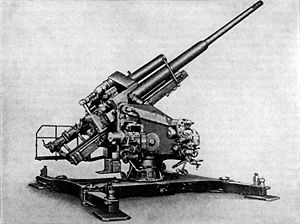Development of the gun began in 1936, with the contract being awarded to Rheinmetall Borsig. The first prototype gun was delivered for testing in late 1937 and completed testing successfully.
| 12.8 cm Flak 40 | |
|---|---|

A static mounted 12.8 cm Flak 40.
| |
| Type | Anti-aircraft gun |
| Place of origin | Nazi Germany |
| Service history | |
| In service | 1942–45 |
| Used by | Nazi Germany |
| Wars | World War II |
| Production history | |
| Designer | Rheinmetall-Borsig |
| Designed | 1936 |
| Manufacturer | Rheinmetall-Borsig |
| Produced | 1942 |
| No. built | Total 1,125 |
| Variants | 12.8 cm FlaK 40 12.8 cm FlaK 40 Zwilling |
| Specifications | |
| Weight | 17,000 kg |
| Length | 7.835 m |
| Barrel length | 61 calibers |
| Shell | 26 kilograms |
| Caliber | 128 mm |
| Breech | Horizontal sliding |
| Recoil | Hydropneumatic |
| Carriage | Static or railcar mounted. |
| Elevation | -3 to +88 degrees |
| Traverse | 360 degrees |
| Muzzle velocity | 880 m/s |
| Maximum firing range | 10,675 m |
| Feed system | Power rammer |
There were four twin mounts on the fortified anti-aircraft Zoo Tower, and they were also on other flak towers protecting Berlin, Hamburg, and Vienna. During the Battle of Berlin, the guns on the Zoo Tower were used successfully to support ground forces, where the heavy 128mm shells obliterated Soviet armor, especially when hit from the side. The rush to capture the Reichstag led to dozens of tanks being destroyed. Approximately 200 were mounted on railcars, providing limited mobility.
The gun fired a 27.9 kg shell at 880 m/s to a maximum ceiling of 14,800 m. Compared with the 88mm FlaK 18 & 36, the 128 used a powder charge four times as great.
Variants
12,8-cm-Flak on a Flak tower.
12.8 cm FlaK 40 -12.8 cm Flakzwilling 40/2 The 12.8 cm Flak 40 ordnance on a static dual mounting with a total weight of 26 tonnes, capable of firing 20 rounds per minute. Used mainly on flak towers. Production started in 1942 with 10 twin sets produced, another eight in 1943, and in February 1945 a total of 34 were available.
12.8 cm PaK 40 A derivative anti-tank gun, rejected in favour of the Krupp 12.8 cm Pak 44, used to arm the Sturer Emil prototypes






Ei kommentteja:
Lähetä kommentti
Any explosive ammunition or empty cores, you can put in this.